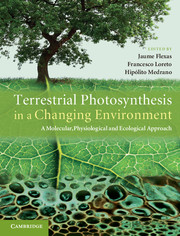 Terrestrial Photosynthesis in a Changing Environment
Terrestrial Photosynthesis in a Changing Environment Book contents
- Frontmatter
- Contents
- List of contributors
- Preface
- Acknowledgements
- List of abbreviations
- 1 Terrestrial photosynthesis in a changing environment
- Part I Photosynthesis
- Part II Measuring photosynthesis
- Part III Photosynthetic response to single environmental factors
- Part IV Photosynthesis in time
- 23 Photosynthesis during leaf development and ageing
- 24 Evolution of photosynthesis I: basic leaf morphological traits and diffusion and photosynthetic structures
- 25 Evolution of photosynthesis II: evolution and expansion of CAM and C4 photosynthetic types
- Part V Photosynthesis in space
- Part VI Photosynthesis in a global context
- References
- Index
25 - Evolution of photosynthesis II: evolution and expansion of CAM and C4 photosynthetic types
Published online by Cambridge University Press: 05 March 2013
- Frontmatter
- Contents
- List of contributors
- Preface
- Acknowledgements
- List of abbreviations
- 1 Terrestrial photosynthesis in a changing environment
- Part I Photosynthesis
- Part II Measuring photosynthesis
- Part III Photosynthetic response to single environmental factors
- Part IV Photosynthesis in time
- 23 Photosynthesis during leaf development and ageing
- 24 Evolution of photosynthesis I: basic leaf morphological traits and diffusion and photosynthetic structures
- 25 Evolution of photosynthesis II: evolution and expansion of CAM and C4 photosynthetic types
- Part V Photosynthesis in space
- Part VI Photosynthesis in a global context
- References
- Index
Summary
Introduction
The evolutionary traits described in the previous chapter are common to all photosynthetic types, and evolved originally in C3-like species. Under current atmospheric conditions, the O2 inhibition of photosynthesis occurs through oxygenation of RuBP and subsequent loss of CO2 through the reactions of photorespiration in C3 plants. Consequently, a very significant part of photosynthetic evolution in vascular plants has been the development of mechanisms for reducing photorespiration by concentrating CO2 around Rubisco, thus returning this enzyme to an atmospheric condition that resembles the primitive earth. These CO2-concentrating mechanisms are known as CAM and C4 photosynthesis, while all other plants are referred to as C3. Other CO2-concentrating mechanisms exist in some algae and cyanobacteria (Kaplan and Reinhold, 1999; Raven et al., 2008), but these will not be discussed here.
The evolutionary origins of CAM and C4 are presumably tied to changes in paleoclimates and atmospheres, particularly to historic variations in CO2 and O2, and locally warm climates (Fig. 24.2 in previous chapter). Under higher CO2 partial pressure and/or lower temperature the C3 pathway fixation does not exhibit limitations that would put a premium on coupling it with a CAM or C4 pathway. The origins of vascular plants date to around the mid-Silurian (~440 MA, Fig. 24.1 in previous chapter) and these plants were likely C3, although the astomatous CAM plant Stylites andicola has been suggested as a possible model of early plant evolution (Keeley et al., 1984). Coupling the C3 pathway with one of the CO2-concentrating mechanisms, CAM or C4, occurred subsequent to the emergence of vascular plants and possibly arose more than once over the past 400 million years.
- Type
- Chapter
- Information
- Terrestrial Photosynthesis in a Changing EnvironmentA Molecular, Physiological, and Ecological Approach, pp. 386 - 396Publisher: Cambridge University PressPrint publication year: 2012
- 2
- Cited by


